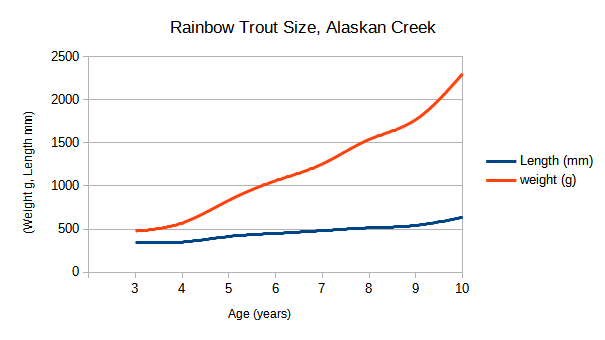Rainbow trout can grow to impressive lengths, and today we’ll dive into the topic to satisfy your curiosity.
According to the International Game Fish Association (IGFA), the heaviest rainbow trout on record weighed a staggering 21.77 kg (48 lb 0 oz). This impressive catch was made in Lake Diefenbaker, Canada back in 2009. Additionally, the IGFA All-Tackle Length World Record for rainbow trout stands at 94 cm (37 inches), and this particular fish was caught in the Tekkapo Canals of New Zealand in 2020.
It’s worth mentioning that unofficial reports suggest even larger rainbow trout have been encountered. For example, there are photographic records of a 98 cm (38-inch) trout caught from the same Tekkapo Canals mentioned earlier. Similarly, the record-breaking 48 lb rainbow trout that weighed in at 21.77 kg is said to have unofficially measured an astonishing 42 inches long. These instances demonstrate that there are certainly fish out there larger than the current official world records.
To add another interesting fact to the mix, in 2021, a steelhead measuring 39.25 inches long was caught in the South Fork Clearwater River. While steelhead are closely related to rainbow trout, they are a distinct subspecies known for their migratory behavior.
So, when it comes to the size that rainbow trout can reach, there are some impressive records on the books, but unofficial accounts and personal anecdotes suggest that even larger fish might be out there. The world of fishing always holds surprises, and it’s exciting to think about the potential size of these magnificent creatures.
Remember, the size of a fish can vary depending on various factors such as habitat, genetics, and food availability. So, keep your eyes open and your fishing rod ready, because you never know when you might come across a monster rainbow trout of your own! Happy fishing!
What is the average size of rainbow trout?
According to the US Fish and Wildlife Service, the average rainbow trout is around 16 inches in length (source). A 16inch Rainbow typically weighs just under 2lb.
The chart below shows an approximation of the growth rate of rainbow trout from a creek in Alaska.
As can be seen, after reaching maturity Rainbow trout continue to grow at a fairly consistent rate. They also grow heavier faster than they increase in length.
This suggests, older more mature fish are typically in better condition.

I will note, that harsh environmental conditions can easily stunt or slow growth. A rainbow trout in an Alaskan creek, where the growing season is short will grow slower than a fish further south in a more temperate climate.
So it is not uncommon for 4 year old fish from a highly productive river to be larger than much older trout from rivers where the growing season is heavily restricted.
Few trout get older than 8 years, and those which remain are usually large fish. I suspect that large strong trout are more likely to reach an old age which could explain the acceleration in growth rate towards the end of their life.
How big do ‘wild’ rainbow trout grow?
The world record Rainbow trout was a genetically engineered fish to make it infertile. There is certainly quite a bit of controversy regarding the legitimacy of such fish.
Well, many large ‘wild rainbows’ have been caught from the Tekapo Canal in New Zealand. These trout were born in the wild, and usually, spawn. The longest I have seen was 98cm and some do weigh in at over 40lb.
But, some might say. These trout live in man-made canals and often feast on artificial fish pellets. Are they truly wild fish? How big do wild rainbow trout get when they grow in a wild river or lake?
Well, the longest Rainbow trout I know of caught from a ‘wild river’ was the 39.25” Steelhead from the South Fork of the Clearwater River in Idaho. Although, the Idaho Fish and Game believes it was probably a hatchery fish. So not quite a truly wild bow.
Factors that influence the growth rate of Rainbow trout
1. Food Supply: To grow to their potential rainbow trout need readily available food. The largest rainbow trout are ones that typically live in one of three places. Beneath fish farms, where they gorge themselves on pellets, In the tailwater of hydroelectric dams where they get a constant source of food washed through the turbines, and finally in the nutrient rich waters offshore.
2. Water temperature: Water that is too warm, or too cold can slow the growth of rainbow trout. Rainbow trout which live in very cold climates tend to grow slower than fish that live in more temperate waters. In climates that are too warm growth also slows. Rainbow trout grow best in waters that are cool, but consistent in temperature. Such conditions are usually enjoyed by trout that travel out to sea or who live in larger lakes or tailwaters.
3. Genetics: There is a lot of genetic variation within rainbow trout populations. Some strains of Rainbow trout grow faster. Hatchery and farm strains are usually selected for maximum growth rate. This has been further enhanced via genetic modification and the breeding of sterile fish.
Age at which Rainbow trout reach their maximum size?
Rainbow trout continue to grow for most of their life, but most trout reach their maximum weight potential around 10 years of age. Trout older than that, might grow in length, but due to the onset of age, they struggle to maintain their condition and can even start losing weight.
Few rainbow trout actually reach that age, most rainbows do not survive beyond their 8th year in cold climates, and their 6th year in warmer waters.
Rainbows survive longer in cold climates because they grow slower, and often do not spawn until their third year.
Do steelheads grow larger than Rainbow trout?
While steelhead and rainbow trout are indeed the same species, there are some differences in their growth patterns. Let’s explore the topic further.
In terms of maximum size, it’s generally observed that steelhead tend to grow to slightly smaller sizes compared to rainbow trout. Many line class records for steelhead range from 30 to 35 pounds, which is lighter than the monstrous river rainbows we discussed earlier. However, it’s important to note that individual fish within a species can vary in size, and there are always exceptions to the average.
On average, steelhead do tend to grow larger and more powerful compared to river rainbows. This is because they benefit from a more consistent food supply in the ocean. Their time spent in the sea allows them to access abundant food sources, resulting in increased size and strength.
In terms of length, the longest recorded steelhead measured 39.25 inches. In comparison, the longest rainbow trout, albeit unofficially measured, came in at an impressive 42 inches. Again, these are exceptional cases, and individual fish sizes can vary.
However, it’s important to consider that steelhead, despite their larger average size, still face challenges in their environment. They have to hunt for their food, evade predators, and embark on lengthy spawning migrations. These factors can limit their growth potential to some extent.
On the other hand, the largest rainbow trout often lead relatively comfortable lives. For example, some can be found resting beneath fish farms, where they readily consume the abundance of fish pellets that wash beneath the farms. Additionally, there are genetically engineered sterile rainbow trout, such as the world record fish caught in Lake Diefenbaker, which do not expend energy on spawning. This means that all their energy goes into growth, allowing them to reach massive sizes given the right conditions.
So, while on average, steelhead tend to be larger than river rainbows, individual variations, environmental factors, and genetic engineering can lead to exceptional cases of rainbow trout reaching impressive sizes. Nature always holds surprises, and the size of these fish is no exception!
Do Rainbow trout grow larger than Brown trout?
When looking at the official records, the IGFA world record for brown trout stands at 20.10 kg (44 lb 5 oz). In contrast, the world record for rainbow trout weighs in slightly higher at 21.77 kg (48 lb 0 oz). However, it’s worth noting that the world record rainbow trout was a genetically modified sterile fish, allowing it to achieve such an exceptional size.
When considering unmodified fish, the largest individuals of both brown trout and rainbow trout can be quite comparable in weight and size. Under ideal conditions in the wild, both species have the potential to reach 40 pounds or more. They possess remarkable growth capabilities given the right environment and resources.
In fact, I have some exciting new information for you! During my research, I stumbled upon fascinating records from the pre-1950s era. The alpine lakes of Austria and Germany hold legends of massive resident brown trout, locally known as Seeforelle in German. Among these legends, one catch stands out as the largest documented with photographic evidence. In 1938, a net capture from Lake Attersee, Austria unveiled a colossal brown trout weighing an astonishing 34 kg, just under 75 pounds. This remarkable find showcases the incredible potential size that brown trout can reach.
So, in summary, while the official records might indicate a slightly higher weight for rainbow trout, when comparing unmodified fish in the wild, both brown trout and rainbow trout have the capacity to grow to impressive sizes. The fascinating stories of massive brown trout, like the one from Lake Attersee, highlight the remarkable potential within this species.
What is the largest Rainbow trout caught in the United States?
The largest Rainbow trout caught in the United States measured 41 inches and was estimated to weigh 38.2lb. It was caught in the Feather River just downstream from the Oroville Dam, California.
At 41” it betters the current IGFA world length record for Rainbow Trout but is 10lb short of the current world record for weight.
Conclusion
In conclusion, rainbow trout have the potential to grow to impressive sizes. The heaviest recorded rainbow trout weighed 21.77 kg (48 lb 0 oz), while the longest officially documented one measured 94 cm (37 inches). Unofficial reports and personal accounts suggest even larger individuals exist, with some photographs showing a 98 cm (38-inch) trout. Additionally, there are genetically modified rainbow trout that can reach massive sizes due to their sterile nature. Overall, rainbow trout can grow to significant lengths, and the world of fishing always holds surprises when it comes to the size of these magnificent fish. For more information on the topic, visit this page: How big do trout actually grow? Monsters that surpass the records.

